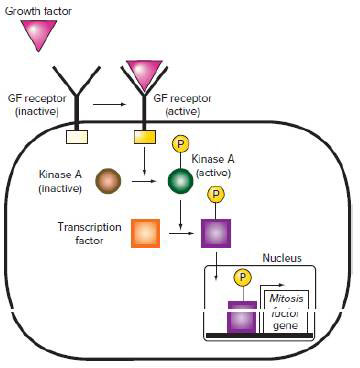
Concept explainers
A generic signaling cascade is shown in the following figure. A growth factor (GF) binds to a growth factor receptor, activating the kinase function of an intracellular domain of the growth factor receptor. One substrate of the growth factor receptor kinase is another kinase, kinase A, that has enzymatic activity only when it is itself phosphorylated by the GF receptor kinase. Activated kinase A adds phosphate to a transcription factor. When it is unphosphorylated, the transcription factor is inactive and stays in the cytoplasm. When it is phosphorylated by kinase A, the transcription factor moves into the nucleus and helps turn on the transcription of a mitosis factor gene whose product stimulates cells to divide.

| a. | The following list contains the names of the genes encoding the corresponding proteins. Which of these could potentially act as a proto-oncogene? Which might be a tumor-suppressor gene?
|
||||||||||||||||||
| Though it is not pictured, the cell in the figure also has a phosphatase, an enzyme that removes phosphates from proteins—in this case, from the transcription factor. This phosphatase is itself regulated by kinase A. | |||||||||||||||||||
| b. | What would you expect to be the effect when kinase A adds a phosphate group to the phosphatase? Would this activate the phosphatase enzyme or inhibit it? Explain. | ||||||||||||||||||
| c. | Is the phosphatase gene likely to be a proto-oncogene or a tumor-suppressor gene or neither? | ||||||||||||||||||
| d. | Several mutations are listed below. For each, indicate whether the mutation would lead to excessive cell growth or decreased cell growth if the cell were either homozygous for the mutation, or heterozygous for the mutation and a wild-type allele. Assume that 50% of the normal activity of all these genes is sufficient for normal cell growth.
|
||||||||||||||||||
Want to see the full answer?
Check out a sample textbook solution
Chapter 20 Solutions
ND STONY BROOK UNIVERSITY LOOSELEAF GENETICS: FROM GENES TO GENOMES
- 18. Watch this short youtube video about SARS CoV-2 replication. SARS-CoV-2 Life Cycle (Summer 2020) - YouTube.19. What is the name of the receptor that SARS CoV-2 uses to enter cells? Which human cells express this receptor? 20. Name a few of the proteins that the SARS CoV-2 mRNA codes for. 21. What is the role of the golgi apparatus related to SARS CoV-2arrow_forwardState the five functions of Globular Proteins, and give an example of a protein for each function.arrow_forwardDiagram of check cell under low power and high powerarrow_forward
- a couple in which the father has the a blood type and the mother has the o blood type produce an offspring with the o blood type, how does this happen? how could two functionally O parents produce an offspring that has the a blood type?arrow_forwardWhat is the opening indicated by the pointer? (leaf x.s.) stomate guard cell lenticel intercellular space none of thesearrow_forwardIdentify the indicated tissue? (stem x.s.) parenchyma collenchyma sclerenchyma ○ xylem ○ phloem none of thesearrow_forward
- Where did this structure originate from? (Salix branch root) epidermis cortex endodermis pericycle vascular cylinderarrow_forwardIdentify the indicated tissue. (Tilia stem x.s.) parenchyma collenchyma sclerenchyma xylem phloem none of thesearrow_forwardIdentify the indicated structure. (Cucurbita stem l.s.) pit lenticel stomate tendril none of thesearrow_forward
- Identify the specific cell? (Zebrina leaf peel) vessel element sieve element companion cell tracheid guard cell subsidiary cell none of thesearrow_forwardWhat type of cells flank the opening on either side? (leaf x.s.) vessel elements sieve elements companion cells tracheids guard cells none of thesearrow_forwardWhat specific cell is indicated. (Cucurbita stem I.s.) vessel element sieve element O companion cell tracheid guard cell none of thesearrow_forward
 Biology 2eBiologyISBN:9781947172517Author:Matthew Douglas, Jung Choi, Mary Ann ClarkPublisher:OpenStax
Biology 2eBiologyISBN:9781947172517Author:Matthew Douglas, Jung Choi, Mary Ann ClarkPublisher:OpenStax Biology: The Dynamic Science (MindTap Course List)BiologyISBN:9781305389892Author:Peter J. Russell, Paul E. Hertz, Beverly McMillanPublisher:Cengage Learning
Biology: The Dynamic Science (MindTap Course List)BiologyISBN:9781305389892Author:Peter J. Russell, Paul E. Hertz, Beverly McMillanPublisher:Cengage Learning Biology (MindTap Course List)BiologyISBN:9781337392938Author:Eldra Solomon, Charles Martin, Diana W. Martin, Linda R. BergPublisher:Cengage Learning
Biology (MindTap Course List)BiologyISBN:9781337392938Author:Eldra Solomon, Charles Martin, Diana W. Martin, Linda R. BergPublisher:Cengage Learning Human Heredity: Principles and Issues (MindTap Co...BiologyISBN:9781305251052Author:Michael CummingsPublisher:Cengage Learning
Human Heredity: Principles and Issues (MindTap Co...BiologyISBN:9781305251052Author:Michael CummingsPublisher:Cengage Learning Human Physiology: From Cells to Systems (MindTap ...BiologyISBN:9781285866932Author:Lauralee SherwoodPublisher:Cengage Learning
Human Physiology: From Cells to Systems (MindTap ...BiologyISBN:9781285866932Author:Lauralee SherwoodPublisher:Cengage Learning Biology Today and Tomorrow without Physiology (Mi...BiologyISBN:9781305117396Author:Cecie Starr, Christine Evers, Lisa StarrPublisher:Cengage Learning
Biology Today and Tomorrow without Physiology (Mi...BiologyISBN:9781305117396Author:Cecie Starr, Christine Evers, Lisa StarrPublisher:Cengage Learning





